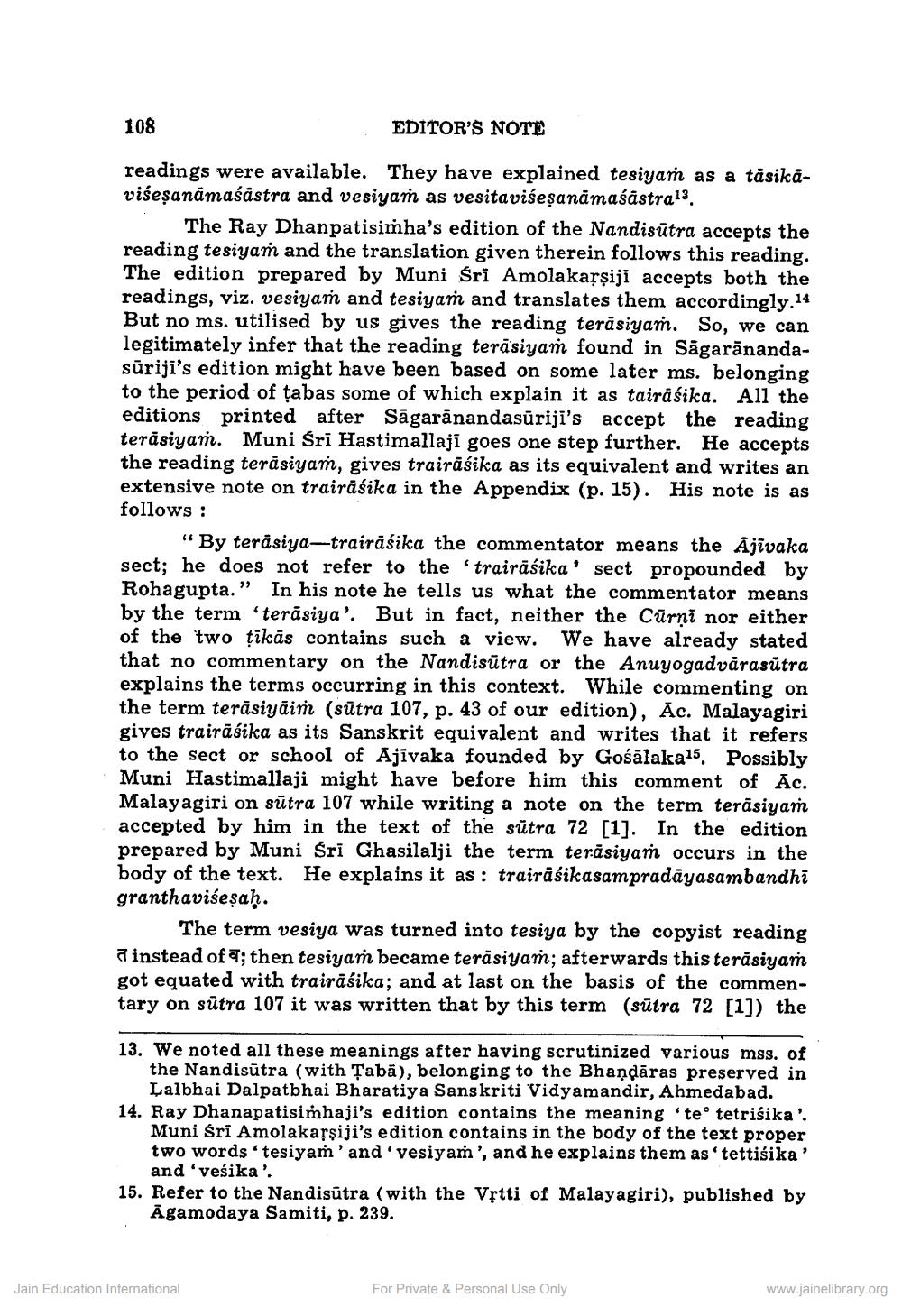________________
108
EDITOR'S NOTE
readings were available. They have explained tesiyam as a tåsikavišeşanāmaśāstra and vesiyam as vesitavićeşanamasastral.
The Ray Dhanpatisimha's edition of the Nandisutra accepts the reading tesiyam and the translation given therein follows this reading. The edition prepared by Muni Sri Amolakarșiji accepts both the readings, viz. vesiyam and tesiyam and translates them accordingly. 14 But no ms. utilised by us gives the reading terasiyam. So, we can legitimately infer that the reading terasiyam found in Sågarānandasūriji's edition might have been based on some later ms. belonging to the period of tabas some of which explain it as tairāśika. All the editions printed after Sāgarānandasūriji's accept the reading teräsiyam. Muni Sri Hastimallaji goes one step further. He accepts the reading terasiyam, gives trairāśika as its equivalent and writes an extensive note on trairāśika in the Appendix (p. 15). His note is as follows:
“By teräsiya-trairāśika the commentator means the Ajivaka sect; he does not refer to the trairāśika' sect propounded by Rohagupta.” In his note he tells us what the commentator means by the term 'terasiya'. But in fact, neither the Cūrni nor either of the two tikās contains such a view. We have already stated that no commentary on the Nandisutra or the Anuyogadvärasutra explains the terms occurring in this context. While commenting on the term terāsiyāim (sūtra 107, p. 43 of our edition), Ac. Malayagiri gives trairāśika as its Sanskrit equivalent and writes that it refers to the sect or school of Ajivaka founded by Gośālaka15. Possibly Muni Hastimallaji might have before him this comment of Ac. Malayagiri on sūtra 107 while writing a note on the term terāsiyam accepted by him in the text of the sūtra 72 [1]. In the edition prepared by Muni Sri Ghasilalji the term terasiyam occurs in the body of the text. He explains it as : trairāśikasampradāyasambandhi granthavišeşah.
The term vesiya was turned into tesiya by the copyist reading a instead of a; then tesiyaṁ became terāsiyam; afterwards this teräsiyam got equated with trairāśika; and at last on the basis of the commentary on sūtra 107 it was written that by this term (sūtra 72 [1]) the
13. We noted all these meanings after having scrutinized various mss. of
the Nandisūtra (with Tabā), belonging to the Bhandāras preserved in
Lalbhai Dalpatbhai Bharatiya Sanskriti Vidyamandir, Ahmedabad. 14. Ray Dhanapatisimhaji's edition contains the meaning teo tetrisika'.
Muni śri Amolakarsiji's edition contains in the body of the text proper two words 'tesiyam' and vesiyam', and he explains them as'tettiśika'
and'veśika'. 15. Refer to the Nandisūtra (with the Vrtti of Malayagiri), published by
Āgamodaya Samiti, p. 239.
Jain Education International
For Private & Personal Use Only
www.jainelibrary.org




